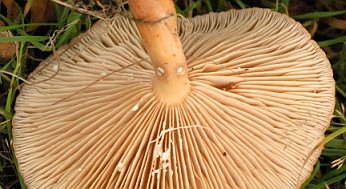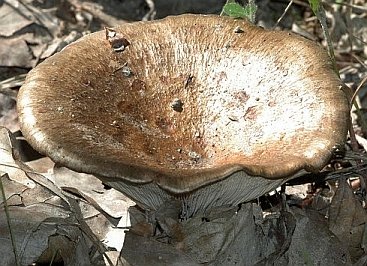Lactarius acris (Bolton) Gray
Synonyms
Agaricus acris Bolton
Agaricus lactifluus [var.] acris (Bolton) Pers.
Lactifluus acris (Bolton) Roussel
Lactifluus acris (Bolton) Kuntze
Common name
Acid milk mushroom
Description
Cap: 3-9 cm diameter, convex-depressed, expanding to broadly vase-shaped, often with a broad obtuse umbo, finally irregularly infundibuloform; surface slimy in wet weather and very shiny, when dry dull and pruinose-velvety; color dark chestnut-brown to gray-brown, mostly with a very slight olive tone, becoming paler tobacco-brown, date brown, or olive-leather brown, when young often with numerous ivory colored or pinkish buff spots, in age also at times entirely ochraceous-brownish to pallid leather-yellowish.
Latex: white, copious in young specimens, quickly changing to bright coral red, later bright orange, fading to rosy white in drying, very acrid on the tongue and lips, and in the throat intensely burning.
Context: rigid, fragile-firm, pithy in the stipe, red when injured, acrid to burning but not as much as the latex, odor unpleasant.
Gills: very crowded, adnate becoming decurrent, thickish, scarcely forked, fairly narrow (3-5 mm), tapered to cap margin, at first ivory white then ochraceous, as seen from the edges with a flesh reddish tint, in age pruinose from the spores, when injured staining red to whitish droplets of latex along the edges.

Stem: 3-8 cm long, 5-15 mm thick, cylindrical or narrowed downward, rarely enlarged downward, often somewhat eccentric, usually curved, smooth to slightly wrinkled, seldom longitudinally striate, the entire length delicately, the entire length delicately pruinose, later naked, dry, solid, stuffed; cortex 1 mm thick, at first pure white, later pallid buff or pale buff toned olive-gray, red to reddish when injured.
Spore print: bright ocher (pale cream according to Gardezi and Ayub, 2003).
Spores: 7.5-9 x 7.5-8.5 µm (5.5-6.5 x 3.2-6 µm says Gardezi and Ayub, 2003), with narrow warts, most of the surface reticulate with heavy amyloid bands.
Habitat: grows on calcium-rich soil, July to November, under beech especially, Europe. Has been reported in Pakistan (Gardezi and Ayub, 2003). As yet not known from North America.
Edibility: inedible.
Medicinal properties
Anti-tumor effects
Polysaccharides extracted from the mycelial culture of L. acris and administered intraperitoneally into white mice at a dosage of 300 mg/kg inhibited the growth of Sarcoma 180 and Ehrlich solid cancers by 100% (Ohtsuka et al., 1973).

My name is Austin Collins.
I've dedicated my life to Mushrooms.
I believe Mushrooms are the best kept secret when it comes to health and well being.
For that reason, I would like to share a company with you that in my opinion makes the best mushroom products on the market.
The company is called Noomadic Herbals, my favorite supplement they make is called "Mushroom Total".
I take their products every day and they have helped me think better and have more energy. Give them a try.
-Austin
References
Gardezi SRA, Ayub N.
Mushroom of Kashmir VI.
Asian J Plant Sci. 2003 2(10):804-10.
Ohtsuka S, Ueno S, Yoshikumi C, Hirose F, Ohmura Y, Wada T, Fujii T, Takahashi E.
Polysaccharides having an anticarcinogenic effect and a method of producing them from species of Basidiomycetes.
UK Patent 1331513, 26 September 1973.
Smith AH, Hesler LR.
Studies on lactarius-III the North American species of section Plinthogali.
Brittonia. 1962 14(4):369-440.
JSTOR preview





I’m interested in learning about mushrooms found in Michigan, USA. Looks like this site will be a good place to start. There are so many musrooms that the learning process appears to be impossible, but going to start. Thanks for popping up on my PC via Google Photo match-up.
Check our article on Michigan.